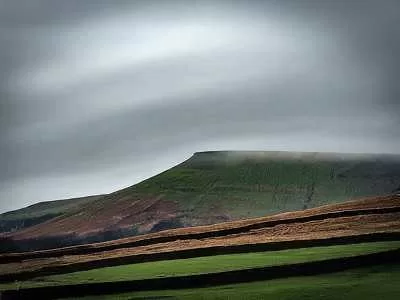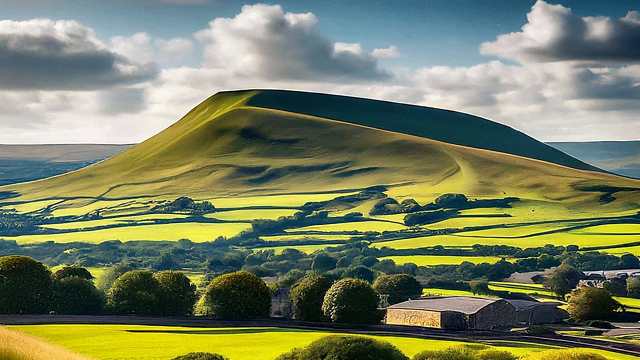Rising majestically over the landscape of East Lancashire, Pendle Hill is a striking gritstone formation that has captured the imagination of locals and visitors alike. Standing at 1,827 feet, Pendle is often shrouded in mist, leading to the local saying: “If you can see Pendle, it’s going to rain; if you can’t see it, it’s already raining.” This whimsical weather lore reflects the hill’s prominent place in the region’s culture and history.
The Mystique of Pendle Hill
Pendle Hill is steeped in local tradition and folklore. One popular rhyme suggests that when Pendle wears its woolly cap, farmers can take a nap, indicating that rain is on the way. The hill’s name itself is a fascinating study in linguistics. The term “Pendle” is a triple tautology; “Pen” comes from the Cumbric word for hill, while the Anglo-Saxons added “hyll,” resulting in the somewhat redundant name “Pendle Hill” (literally “hill-hill Hill”). This linguistic quirk is not unique to Pendle; similar redundancies can be found in other locations, such as Bredon Hill and Artfield Fell.
A Historical Perspective
Pendle Hill is not just a natural wonder; it has historical significance as well. The hill is famously associated with George Fox, the founder of the Religious Society of Friends, commonly known as the Quakers. In his autobiography, Fox recounts his challenging ascent up Pendle Hill, where he felt divinely inspired to gather a great people. He describes discovering a spring of water on the hill, which is now known as George Fox’s Well. Interestingly, some locals still refer to it as Robin Hood’s Well, adding a touch of folklore to the site.

The Witch Trials of Pendle
Pendle Hill is perhaps most notorious for its connection to the Lancashire witch trials of 1612. The area was home to several individuals accused of witchcraft, including Elizabeth Southern, known as Owd Mother Demdike. The tiny hamlet of Newchurch in Pendle, where she lived, is steeped in this dark history. The village features the Church of St. Mary, which has roots dating back to the early 1200s. The west tower of the church, a remnant of a stone structure built in 1544, is known for its small window, dubbed The Eye of God, which once allowed the churchwarden to see approaching wedding or funeral parties.
In the graveyard, many headstones bear the name Nutter, a family linked to the witch trials. One grave is often mistakenly believed to belong to Alice Nutter, a woman executed for witchcraft. However, it’s important to note that witches were not buried in consecrated ground, and executed criminals were typically disposed of near the site of their execution.
Local Attractions and Delights
While Pendle Hill is rich in history, the surrounding villages also offer unique attractions. Downham, located on the opposite side of Pendle, is a picturesque village known for its stunning views. It is said that the Queen Mother once remarked that the view from the porch of St. Leonard’s Church in Downham is the finest in England. The village is also famous for its ice cream, particularly from the local post office, which sells delicious treats. For an even better experience, a short drive to Hudson’s in nearby Chatburn is a must. Their handmade gooseberry ice cream, available seasonally, is a local favorite and made fresh daily without preservatives.
Downham is also notable for its historical significance, having been a site for early Mormon baptisms. The village is unique in that the 2nd Lord Clitheroe has prohibited overhead electricity cables, satellite dishes, and television aerials, preserving its quaint charm. Additionally, the village served as a filming location for the 1961 movie Whistle Down the Wind, further embedding it in cultural history.
Conclusion: A Journey Through Time and Nature
Pendle Hill and its surrounding areas offer a rich tapestry of history, folklore, and natural beauty. From the legends of witches to the inspiring tales of George Fox, the region is steeped in stories that continue to captivate those who visit. Whether you’re hiking up Pendle Hill, exploring the quaint streets of Downham, or enjoying a scoop of gooseberry ice cream, you’ll find that this corner of Lancashire is a treasure trove of experiences waiting to be discovered.
So, pack your bags and set out on an adventure to explore the enchanting landscapes and rich history of Pendle Hill!

